Effect of Sand Size on Mechanical Performance of Cement-Based Composite Containing PVA Fibers and Nano-SiO2
Abstract
1. Introduction
2. Experimental Program
2.1. Materials
2.2. Mix Proportions
2.3. Test Procedures
2.3.1. Mixing
2.3.2. Slump Flowability
2.3.3. Compressive Strength
2.3.4. Flexural Strength
2.3.5. Tensile Strength
2.3.6. Fracture Performance
- (a)
- If , crack will not propagate;
- (b)
- If , crack will stably propagate;
- (c)
- If , crack will unstably propagate.
3. Results and Discussion
3.1. Slump Flowability
3.2. Compressive Strength
3.3. Flexural Strength
3.4. Tensile Strength
3.5. Fracture Performance
4. Conclusions
Author Contributions
Funding
Conflicts of Interest
References
- Ling, Y.; Zhang, P.; Wang, J.; Chen, Y. Effect of PVA fiber on mechanical properties of cementitious composite with and without nano-SiO2. Constr. Build. Mater. 2019, 229, 117068. [Google Scholar] [CrossRef]
- Irshidat, M.R.; Al-Shannaq, A. Using textile reinforced mortar modified with carbon nano tubes to improve flexural performance of RC beams. Compos. Struct. 2018, 200, 127–134. [Google Scholar] [CrossRef]
- Ling, Y.; Wang, K.; Li, W.; Shi, G.; Lu, P. Effect of slag on the mechanical properties and bond strength of fly ash based engineered geopolymer composites. Compos. Part B 2019, 164, 747–757. [Google Scholar] [CrossRef]
- Yu, K.; Wang, Y.; Yu, J.; Xu, S. A strain-hardening cementitious composites with the tensile capacity up to 8%. Constr. Build. Mater. 2017, 137, 410–419. [Google Scholar] [CrossRef]
- Haskett, M.; Mohamed Sadakkathulla, M.; Oehlers, D.; Guest, G.; Pritchard, T.; Sedav, V.; Stapleton, B. Adelaide Research and Scholarship: Deflection of GFRP and PVA fibre reinforced concrete beams. In Proceedings of the 6th International Conference on FRP Composites in Civil Engineering (CICE2012), Rome, Italy, 13–15 June 2012. [Google Scholar]
- Atahan, H.; Pekmezci, B.; Tuncel, E. Behavior of PVA fiber-reinforced cementitious composites under static and impact flexural effects. J. Mater. Civ. Eng. 2013, 25, 10. [Google Scholar] [CrossRef]
- Zhang, Y.; Sun, W.; Li, Z.; Zhou, X.; Eddie; Chau, C. Impact properties of geopolymer based extrudates incorporated with fly ash and PVA short fiber. Constr. Build. Mater. 2008, 22, 370–383. [Google Scholar]
- Viswanath, P.; Thachil, E. Properties of polyvinyl alcohol cement pastes. Mater. Struct. 2008, 41, 123–130. [Google Scholar] [CrossRef]
- Sun, M.; Chen, Y.; Zhu, J.; Sun, T.; Shui, Z.; Ling, G.; Zhong, H.; Zheng, Y. Effect of modified polyvinyl alcohol fibers on the mechanical behavior of engineered cementitious composites. Materials 2019, 12, 37. [Google Scholar] [CrossRef]
- Zhang, W.; Yin, C.; Ma, F.; Huang, Z. Mechanical properties and carbonation durability of engineered cementitious composites reinforced by polypropylene and hydrophilic polyvinyl alcohol fibers. Materials 2018, 11, 1147. [Google Scholar] [CrossRef]
- Cao, R.; Yang, H.; Lu, G. Effects of high temperature on the burst process of carbon fiber/PVA fiber high-strength concretes. Materials 2019, 12, 973. [Google Scholar] [CrossRef]
- Ekaputri, J.; Limantono, H.; Triwulan, T.; Susanto, T.; Abdullah, M. Effect of PVA fiber in increasing mechanical strength on paste containing glass powder. Key Eng. Mater. 2016, 673, 83–93. [Google Scholar] [CrossRef]
- Topic, J.; Proseka, Z.; Indrova, K.; Plachy, T.; Nezerka, V.; Kopecky, L.; Tesarek, P. Effect of PVA modification on the properties of cement composites. Acta Polytechnica 2015, 55, 64–75. [Google Scholar] [CrossRef]
- Bentur, A.; Alexander, M.G. A review on the work of the RILEM TC159-ETC: engineering of the interfacial transition zone in cementitious composites. Mater. Struct. 2000, 33, 82–87. [Google Scholar] [CrossRef]
- Gurrero, P.; Naaman, A.E. Effect of mortar fineness and adhesive agents on pullout response of steel fibers. ACI Mater. J. 2000, 97, 12–20. [Google Scholar]
- Bastos, G.; Patino-Barbeito, F.; Patino-Cambeiro, F.; Armesto, J. Nano-inclusions applied in cement-matrix composites: a review. Materials 2016, 9, 1015. [Google Scholar] [CrossRef] [PubMed]
- NajiGivi, A.; Abdul Rashid, S.; Aziz, F.N.A.; Salleh, M.A.M. Experimental investigation of the size effects of SiO2 nano-particles on the mechanical properties of binary blended concrete. Compos. Part B 2010, 41, 673–677. [Google Scholar] [CrossRef]
- Zhao, H.; Wu, X.; Huang, Y.; Zhang, P.; Tian, Q.; Liu, J. Investigation of moisture transport in cement-based materials using low-field nuclear magnetic resonance imaging. Mag. Concr. Res. 2019, 1–21. [Google Scholar] [CrossRef]
- Gonzalez, M.; Tighe, S.; Hui, K.; Rahman, S.; Oliveira Lima, A. Evaluation of freeze/thaw and scaling response of nano concrete for Portland cement concrete (PCC) pavements. Constr. Build. Mater. 2016, 120, 465–472. [Google Scholar] [CrossRef]
- Zhang, L.; Ma, N.; Wang, Y.; Han, B.; Cui, X.; Yu, X.; Ou, J. Study on the reinforcing mechanisms of nano silica to cement-based materials with theoretical calculation and experimental evidence. J. Compos. Mater. 2016, 50, 4135–4146. [Google Scholar] [CrossRef]
- Gesoglu, M.; Güneyisi, E.; Asaad, D.S.; Muhyaddin, G.F. Properties of low binder ultra-high performance cementitious composites: Comparison of nanosilica and microsilica. Constr. Build. Mater. 2016, 102, 706–713. [Google Scholar] [CrossRef]
- Murthy, A.R.; Ganesh, P. Effect of steel fibres and nano silica on fracture properties of medium strength concrete. Adv. Concr. Constr. 2019, 7, 143–150. [Google Scholar]
- Shafiq, N.; Kumar, R.; Zahid, M.; Tufail, R. Effects of modified metakaolin using nano-silica on the mechanical properties and durability of concrete. Materials 2019, 12, 2291. [Google Scholar] [CrossRef] [PubMed]
- Kim, T.; Kim, J.; Jun, Y. Properties of alkali-activated slag paste using new colloidal nano-silica mixing method. Materials 2019, 12, 1571. [Google Scholar] [CrossRef]
- Assaedi, H.; Alomayri, T.; Shaikh, F.; Low, I. Influence of nano silica particles on durability of flax fabric reinforced geopolymer composites. Materials 2019, 12, 1459. [Google Scholar] [CrossRef]
- Che, J.; Wang, D.; Liu, H.; Zhang, Y. Mechanical properties of desert sand-based fiber reinforced concrete (DS-FRC). Appl. Sci. 2019, 9, 1857. [Google Scholar] [CrossRef]
- Kang, S.H.; Ahn, T.H.; Kim, D.J. Effect of grain size on the mechanical properties and crack formation of HPFRCC containing deformed steel fibers. Cem. Concr. Res. 2012, 42, 710–720. [Google Scholar] [CrossRef]
- Common Portland Cement; GB 175-2007; China Standards Press: Beijing, China, 2007.
- Fly Ash Used for Cement and Concrete; GB/T 1596-2017; China Standards Press: Beijing, China, 2017.
- Standard Practice for Mechanical Mixing of Hydraulic Cement Pastes and Mortars of Plastic Consistency; ASTM C305-14; ASTM International: West Conshohocken, PA, USA, 2014.
- Kim, S.W.; Yun, H.D. Flexural behaviour of reinforced concrete beams strengthened with a composite reinforcement layer: BFRP grid and ECC. Constr. Build. Mater. 2016, 115, 424–437. [Google Scholar]
- Felekoglu, B.; Tosun-Felekoglu, K.; Ranade, R.; Zhang, Q.; Li, V.C. Influence of matrix flowability, fiber mixing procedure, and curing conditions on the mechanical performance of HTPP-ECC. Compos. Part B 2014, 60, 359–370. [Google Scholar] [CrossRef]
- Wu, C.; Li, V.C. Thermal-mechanical behaviors of CFRP-ECC hybrid under elevated temperatures. Compos. Part B 2017, 110, 255–266. [Google Scholar] [CrossRef]
- Standard Test Method for Slump Flow of Self-Consolidating Concrete; ASTM C1611; ASTM International: West Conshohocken, PA, USA, 2018.
- Standard for Test Method of Performance on Building Mortar; JGJ/T70-90; China Communications Press: Beijing, China, 2009.
- Test Methods of Cement and Concrete for Highway Engineering; JTJ E30-2005; China Communications Press: Beijing, China, 2005.
- Guan, J.; Hu, X.; Yao, X.; Wang, Q.; Li, Q.; Wu, Z. Fracture of 0.1 and 2 m long mortar beams under three-point-bending. Mater. Des. 2017, 133, 363–375. [Google Scholar] [CrossRef]
- Norm for Fracture Test of Hydraulic Concrete; DL/T 5332-2005; Electric Power Industry Standard: China, 2005.
- Aydin, A.C. Self compactability of high volume hybrid fiber reinforced concrete. Constr. Build. Mater. 2007, 21, 1149–1154. [Google Scholar] [CrossRef]
- Cao, P.; Feng, D.; Zhou, C.; Zuo, W. Study on fracture behavior of polypropylene fiber reinforced concrete with bending beam test and digital speckle method. Comput. Concr. 2014, 14, 527–546. [Google Scholar] [CrossRef]
- Golewski, G.L. Green concrete composite incorporating fly ash with high strength and fracture toughness. J. Clean. Prod. 2018, 172, 218–226. [Google Scholar] [CrossRef]
- Golewski, G.L. Effect of curing time on the fracture toughness of fly ash concrete composites. Compos. Struct. 2018, 185, 105–112. [Google Scholar] [CrossRef]
- Reynolds, C.E.; Steedman, J.C.; Threlfall, A.J. Reynolds’s Reinforced Concrete Designer’s Handbook, 11th ed.; Taylor & Francis Group: New York, NY, USA, 2008. [Google Scholar]
- Apebo, A.J.; Shiwua, N.S. Effect of water-cement ratio on the compressive strength of gravel-crushed over burnt bricks concrete. Civ. Eng. Res. 2013, 3, 74–81. [Google Scholar]
- Cho, S. Effect of silt fines on the durability properties of concrete. J. Appl. Sci. Eng. 2013, 16, 425–430. [Google Scholar]
- Atmaca, N.; Abbas, M.L.; Atmaca, A. Effects of nanosilica on the gas permeability, durability and mechanical properties of high-strength lightweight concrete. Constr. Build. Mater. 2017, 147, 17–26. [Google Scholar] [CrossRef]
- Haruehansapong, S.; Pulngern, T.; Chucheepsakul, S. Effect of the particle size of nanosilica on the compressive strength and the optimum replacement content of cement mortar containing nano-SiO2. Constr. Build. Mater. 2014, 50, 471–477. [Google Scholar] [CrossRef]
- Abbasi, S.M.; Ahmadi, H.; Khalaj, G. Microstructure and mechanical properties of a metakaolinite-based geopolymer nanocomposite reinforced with carbon nanotubes. Ceram. Int. 2016, 42, 15171–15176. [Google Scholar] [CrossRef]
- Marques, A.S.; Amaral, P.M.; Rosa, L.G.; Fernandes, J.C. Study of aggregate size effect on fracture toughness of petreous macrocomposites (concrete). Mater. Sci. Forum 2010, 636–637, 1342–1348. [Google Scholar] [CrossRef]
- Guan, J.; Yuan, P.; Hu, X.; Qing, L.; Yao, X. Statistical analysis of concrete fracture using normal distribution pertinent to maximum aggregate size. Theor. Appl. Fract. Mech. 2019, 101, 236–253. [Google Scholar] [CrossRef]
- Guan, J.; Li, C.; Wang, J.; Qing, L.; Song, Z.; Liu, Z. Determination of fracture parameter and prediction of structural fracture using various concrete specimen types. Theor. Appl. Fract. Mech. 2019, 100, 114–127. [Google Scholar] [CrossRef]
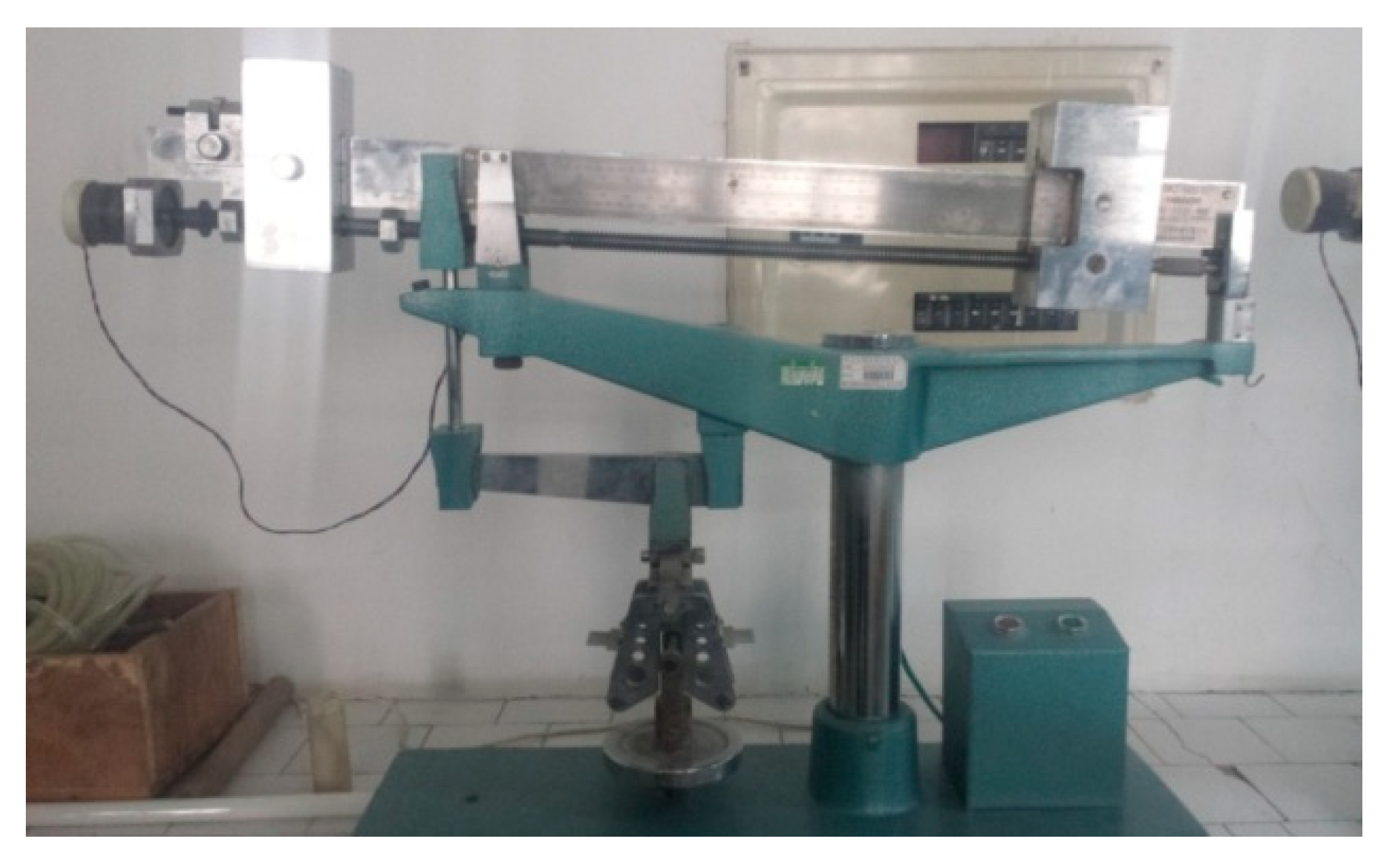
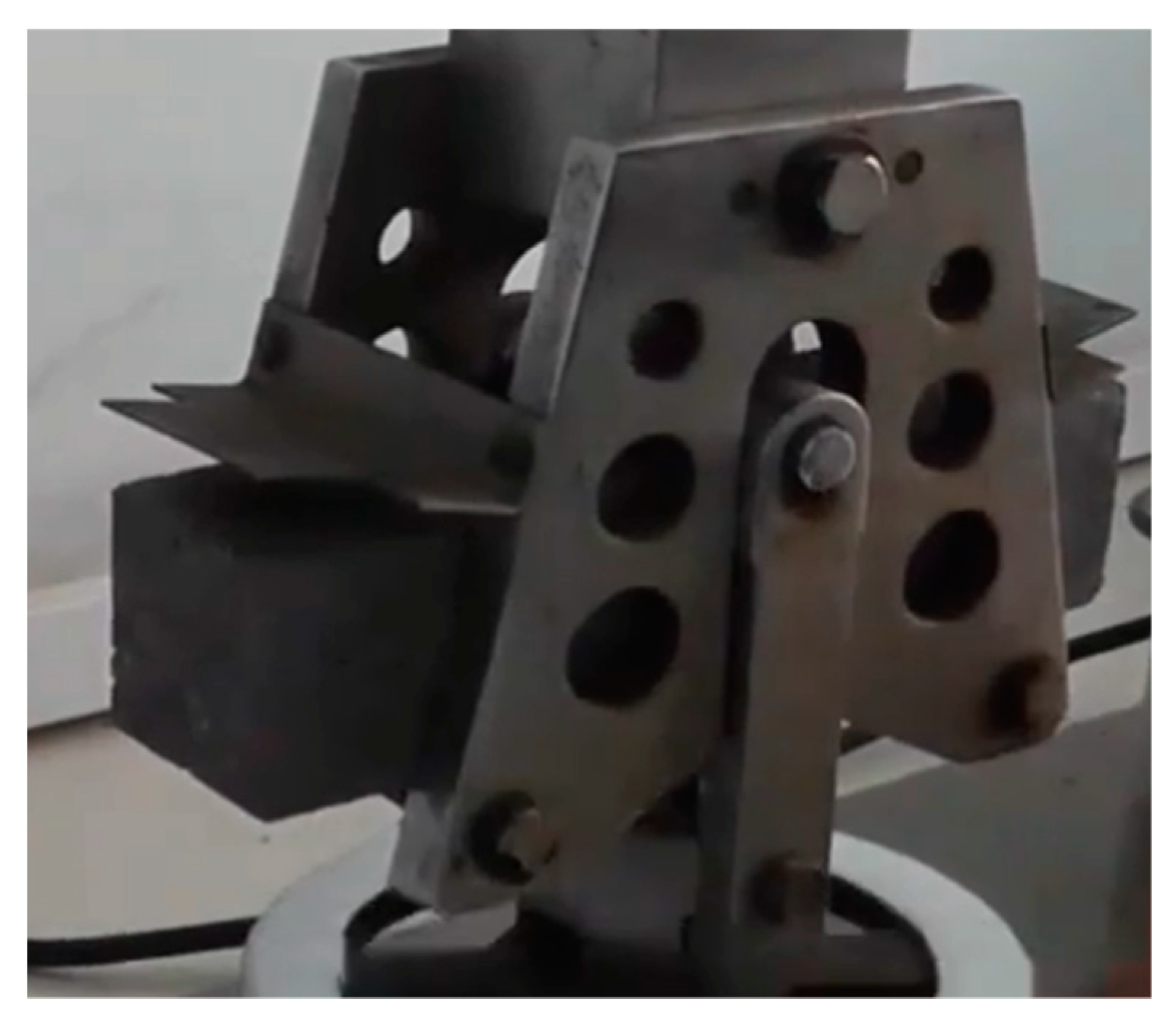
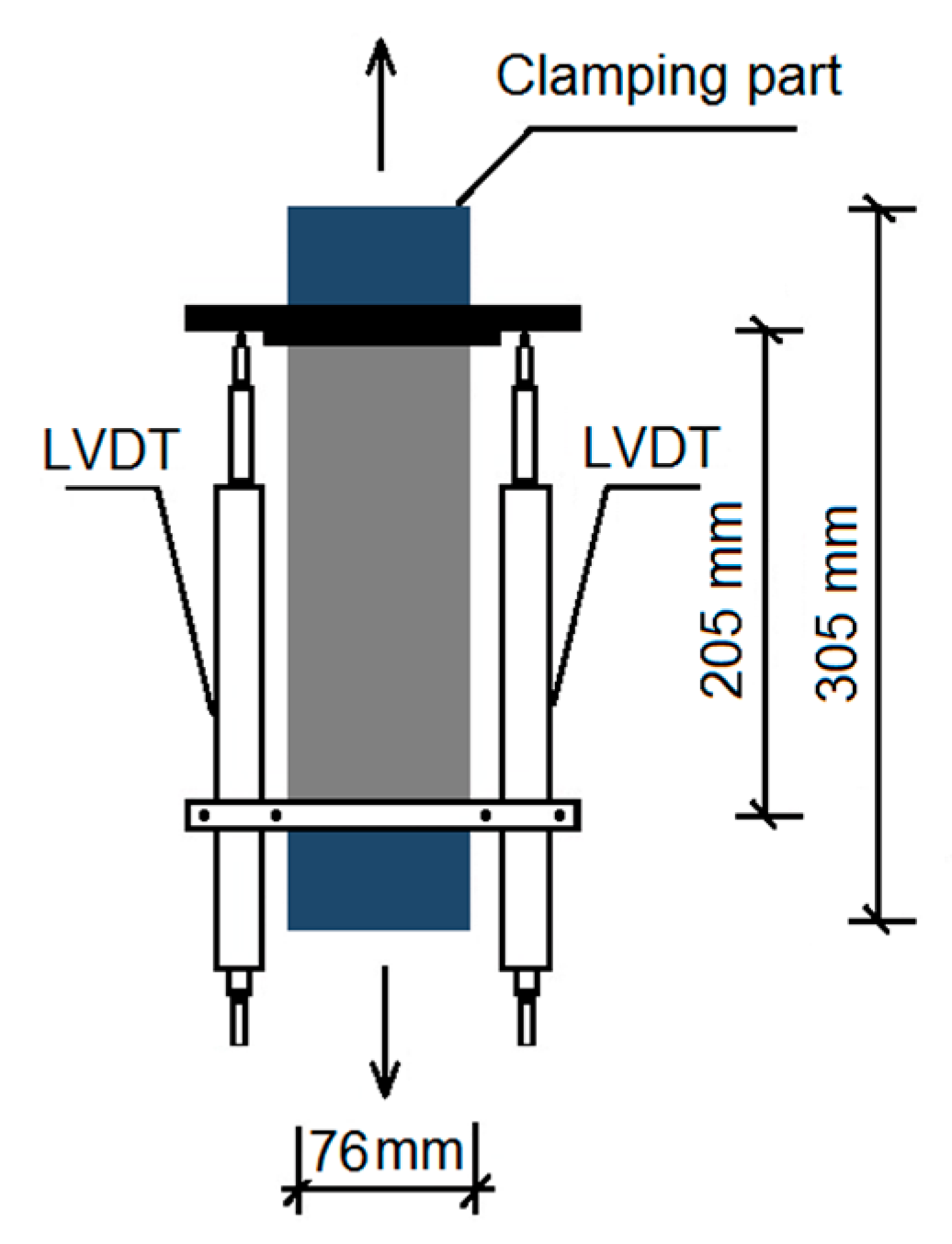
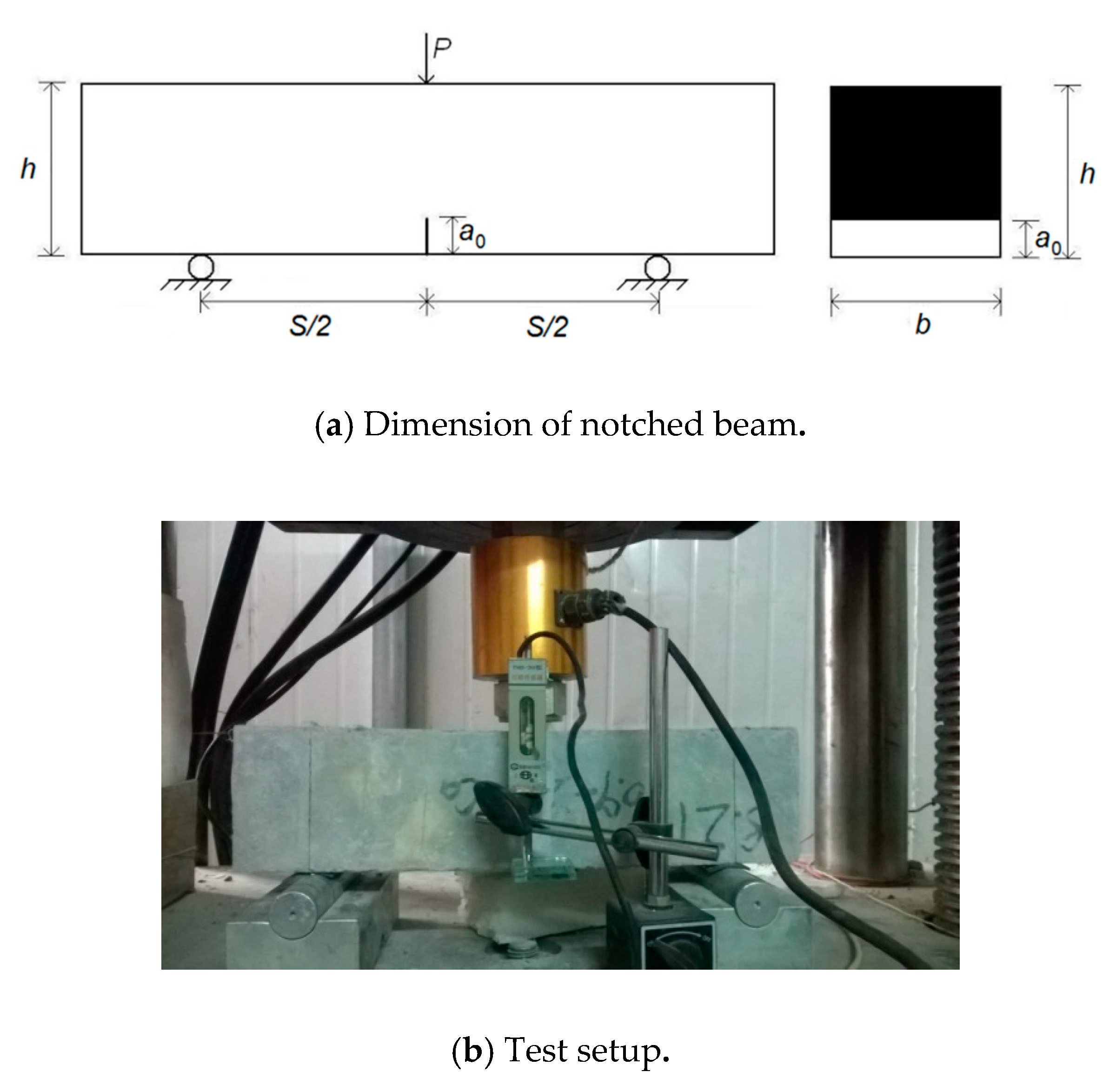
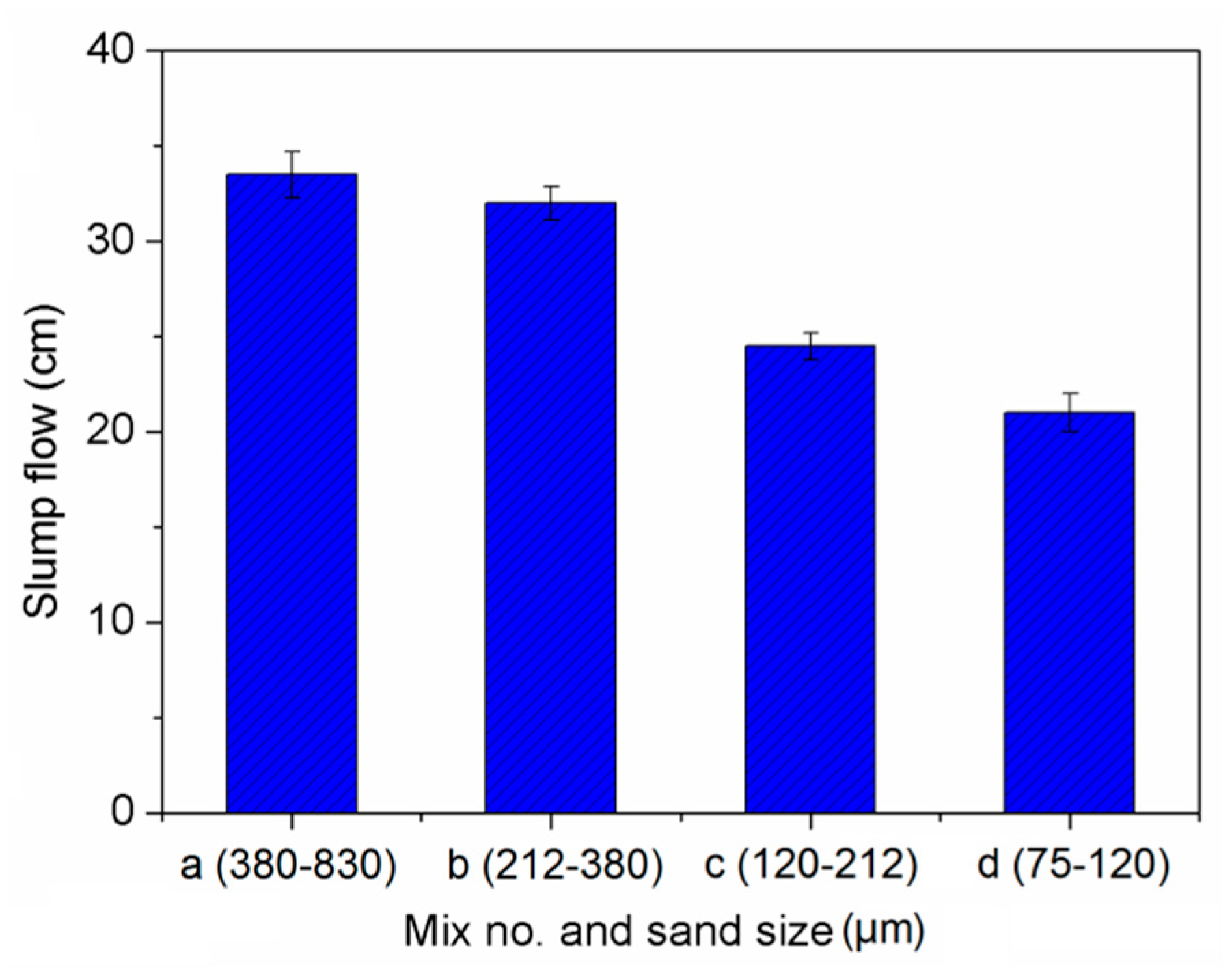
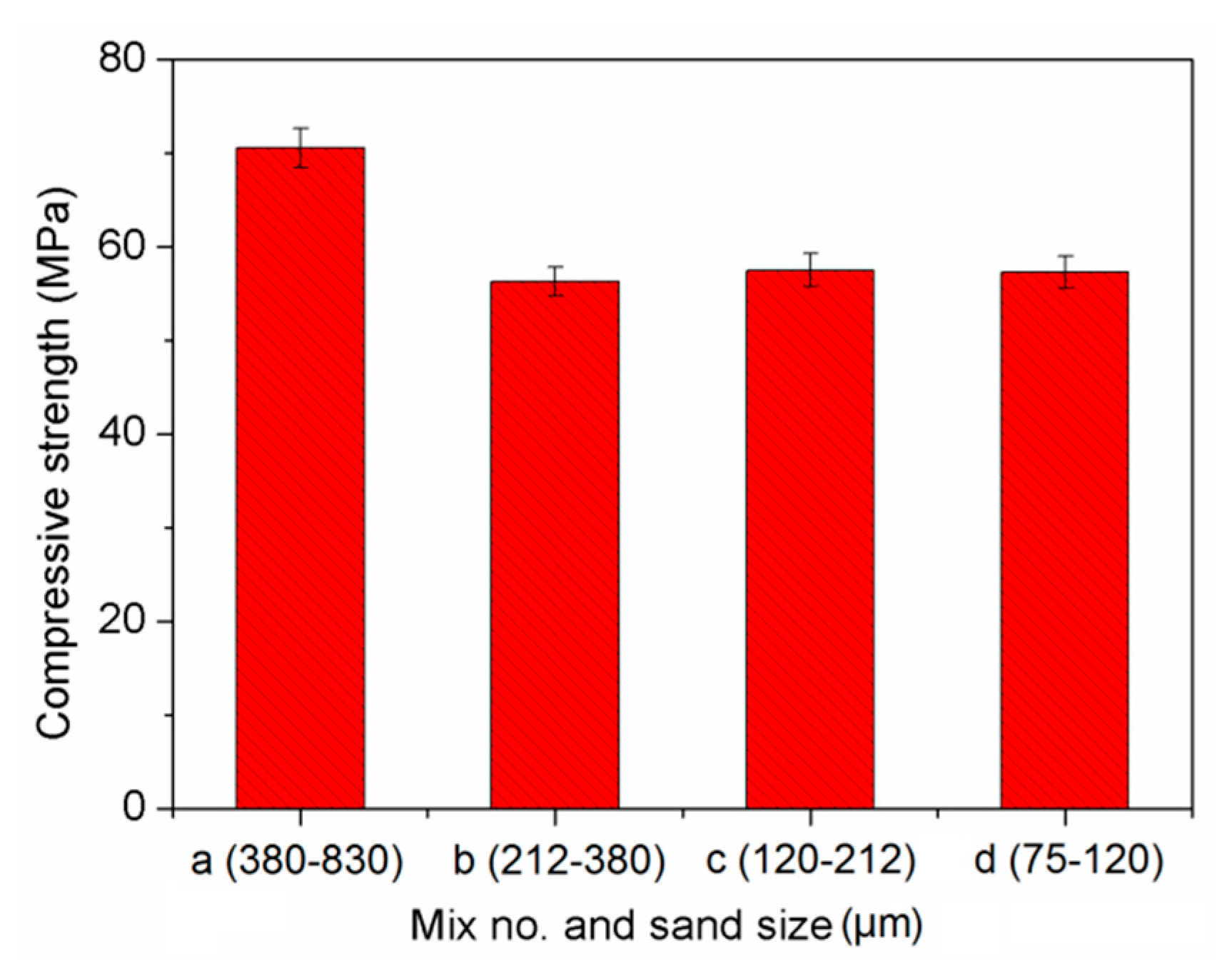
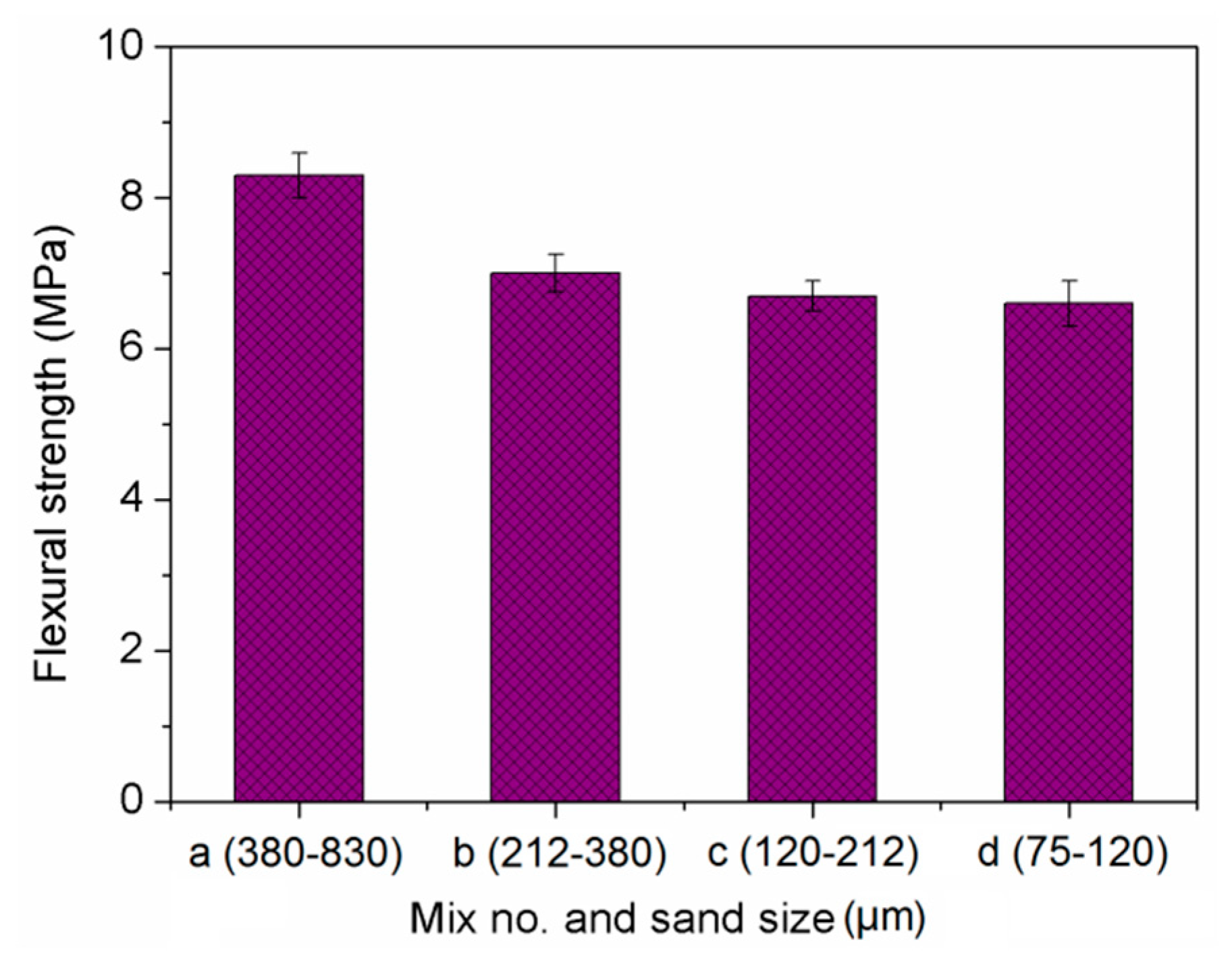
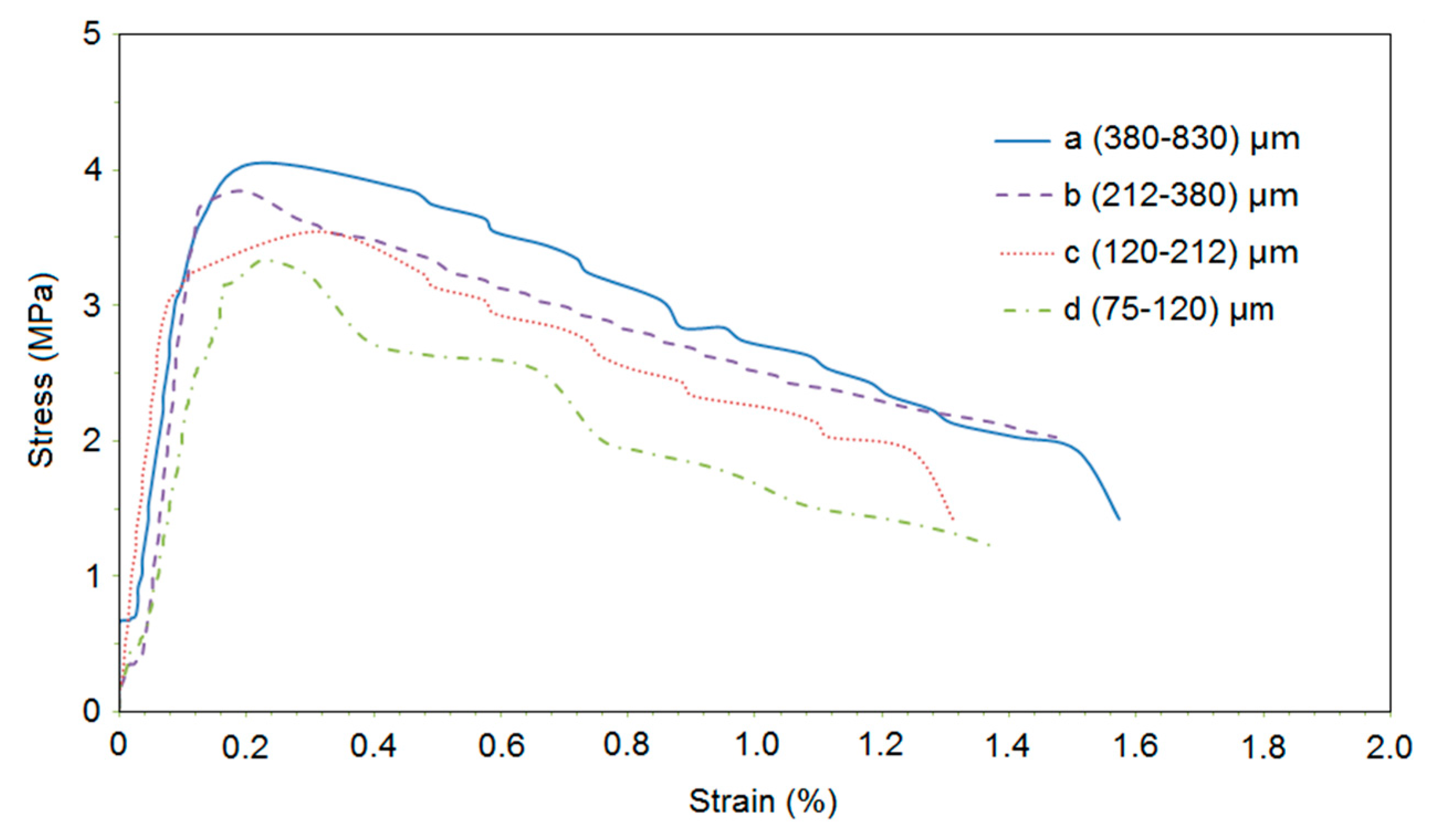
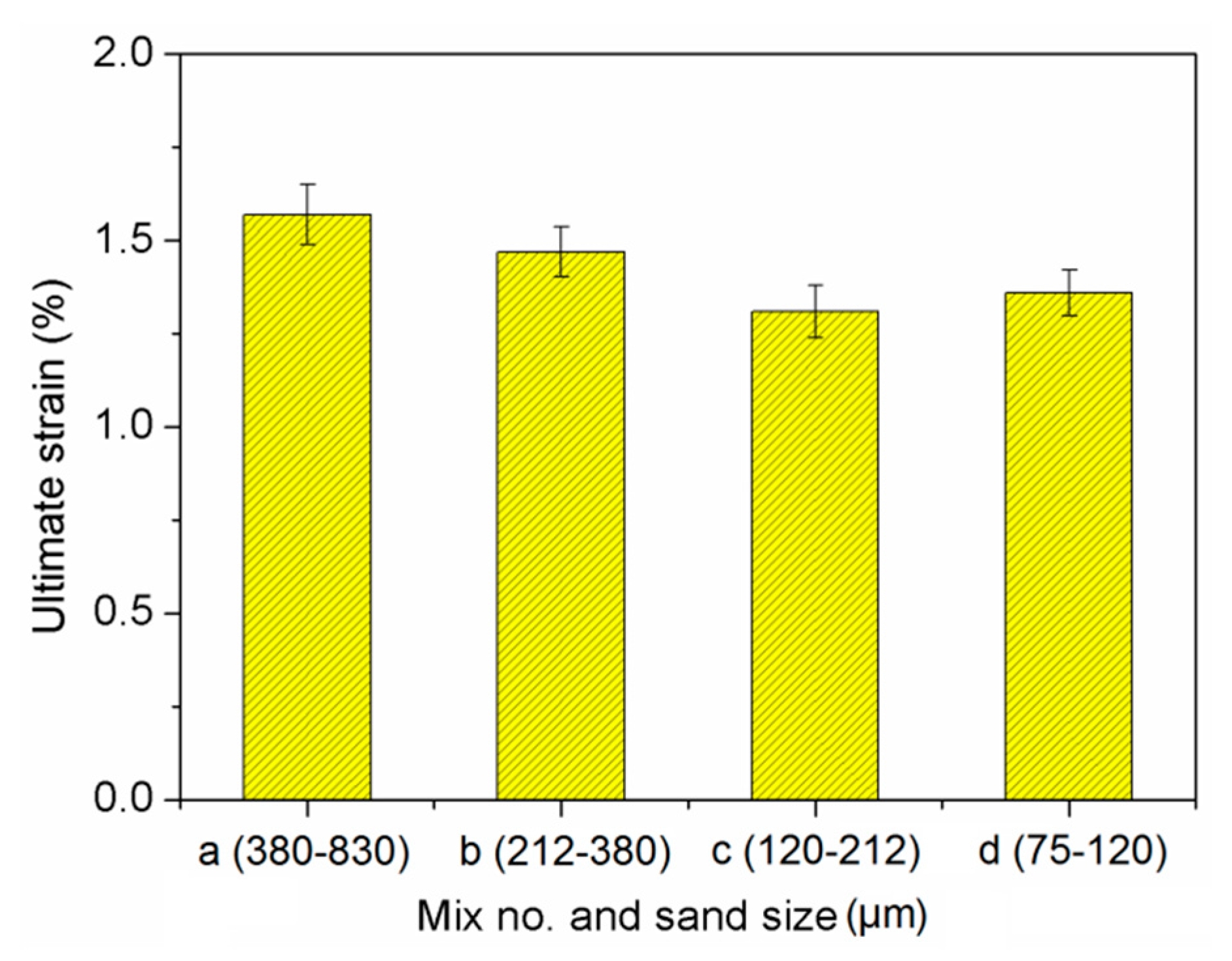
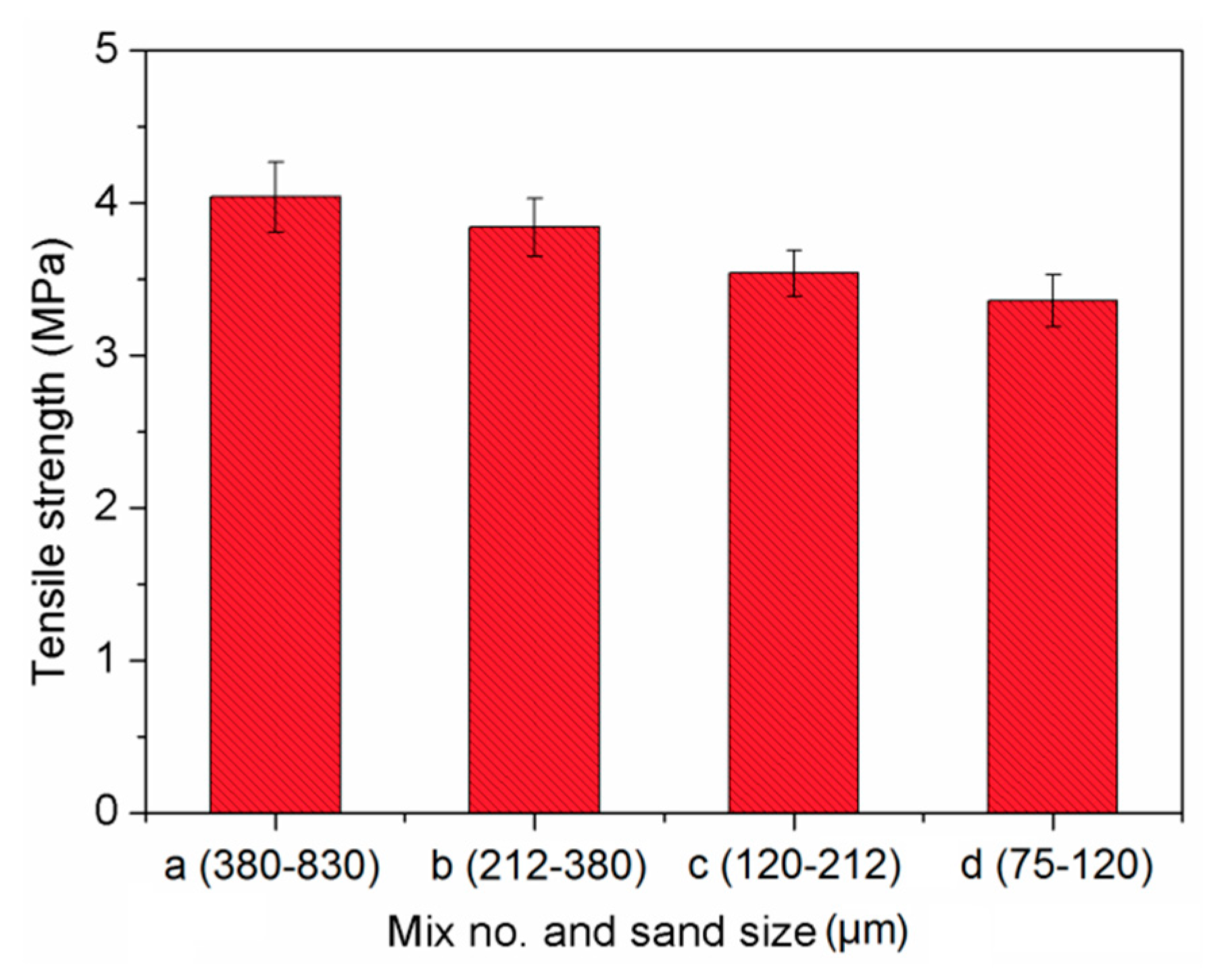
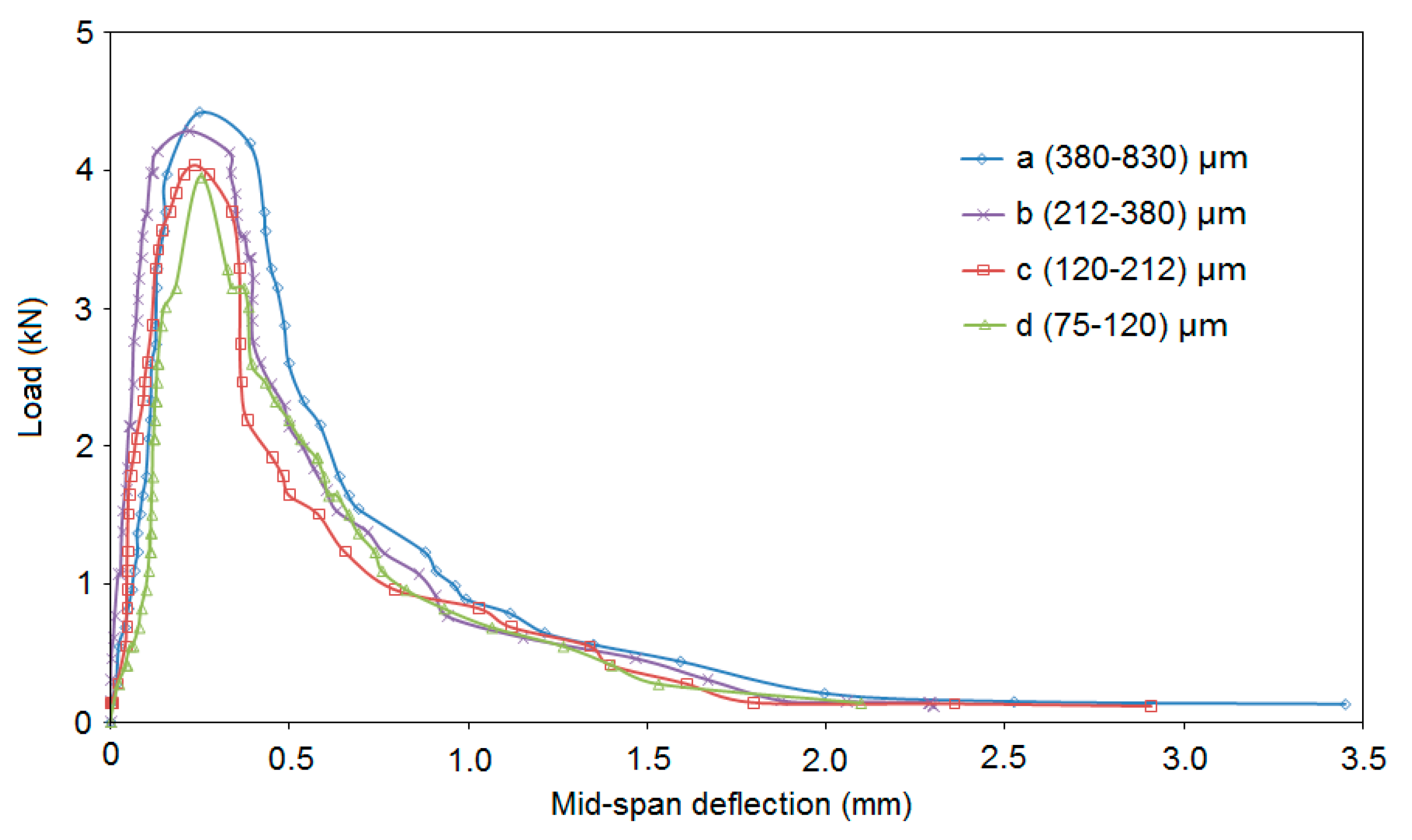

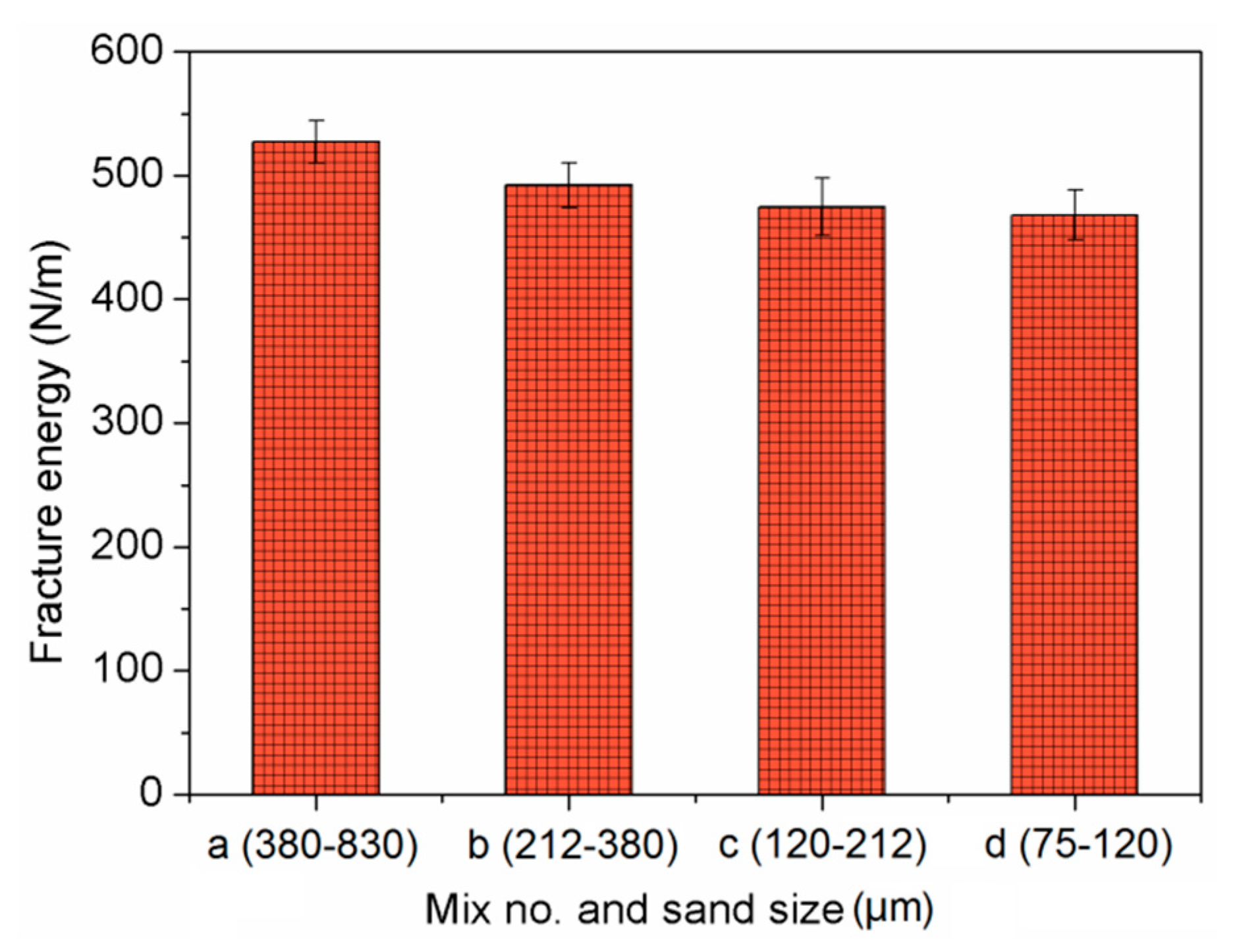


| Composition (%) | Cement | Fly Ash |
|---|---|---|
| SiO2 | 21.05 | 52.12 |
| Al2O3 | 5.28 | 17.86 |
| Fe2O3 | 2.57 | 6.57 |
| CaO | 63.14 | 9.12 |
| MgO | 3.58 | 3.26 |
| Na2O | 0.17 | 2.38 |
| K2O | 0.58 | 2.05 |
| SO3 | 2.39 | 0.23 |
| Specific Gravity | Elongation (%) | Length (mm) | Diameter (μm) | Tensile Strength (MPa) | Water Absorption (%) | Melting Point (°C) |
|---|---|---|---|---|---|---|
| 1.32 | 15 | 9 | 20 | 1400 | <1 | 220 |
| Size (nm) | Content (%) | Specific Surface (m2/g) | Density (g/cm3) | PH |
|---|---|---|---|---|
| 30 | 99.5 | 200 | 0.055 | 6 |
| Density | Alkali Percent (%) | PH | Chloride Percent (%) | Fluidity (mm) | Effectiveness (%) |
|---|---|---|---|---|---|
| 1.06 | 1.2 | 4.62 | 0.078 | 260 | 22.0 |
| Cement (kg/m3) | Fly Ash (kg/m3) | NS (kg/m3) | PVA Fiber (%) | Sand (kg/m3) | Water (kg/m3) | HRWR (kg/m3) |
|---|---|---|---|---|---|---|
| 630 | 350 | 20 | 0.9 | 500 | 380 | 3 |
© 2020 by the authors. Licensee MDPI, Basel, Switzerland. This article is an open access article distributed under the terms and conditions of the Creative Commons Attribution (CC BY) license (http://creativecommons.org/licenses/by/4.0/).
Share and Cite
Ling, Y.-F.; Zhang, P.; Wang, J.; Shi, Y. Effect of Sand Size on Mechanical Performance of Cement-Based Composite Containing PVA Fibers and Nano-SiO2. Materials 2020, 13, 325. https://doi.org/10.3390/ma13020325
Ling Y-F, Zhang P, Wang J, Shi Y. Effect of Sand Size on Mechanical Performance of Cement-Based Composite Containing PVA Fibers and Nano-SiO2. Materials. 2020; 13(2):325. https://doi.org/10.3390/ma13020325
Chicago/Turabian StyleLing, Yi-Feng, Peng Zhang, Juan Wang, and Yan Shi. 2020. "Effect of Sand Size on Mechanical Performance of Cement-Based Composite Containing PVA Fibers and Nano-SiO2" Materials 13, no. 2: 325. https://doi.org/10.3390/ma13020325
APA StyleLing, Y.-F., Zhang, P., Wang, J., & Shi, Y. (2020). Effect of Sand Size on Mechanical Performance of Cement-Based Composite Containing PVA Fibers and Nano-SiO2. Materials, 13(2), 325. https://doi.org/10.3390/ma13020325






